What is a Demi-Porteur bag?
Ever since moving to a bike optimized for a front load I started to push the envelope of how much went in the upper bag vs. panniers. The goal being that the upper bag would accommodate 90% of my daily bike trasportational needs, and the panniers only come out for groceries, camping trips, etc. I keep a regular rotation of tools and clothing layers with me all the time. Add to that things that vary per ride like camera gear, meals, coffee gear, post office runs, etc. I needed maximum volume and flexibility. Starting with the basic form of a traditional randonneuring bag, I pushed some of the dimensions and features without going so far that it became a full porteur bag.
While pushing the boundaries of size and volume I also wanted to shave some weight. The first place I made the weight cut was with material. The design is able to use all of the strong points of the Dimension Polyant XPac, and avoid most of the features that are considered the material’s downside. XPac is a three layer laminate, pack cloth on the outer faces, with a mylar center and a cross weave of polyester fiber on the bias for added load capacity and tear resistance. XPac does not like to be forced into compound curves or situation with high abrasion. The boxy shape takes care of the first. Abrasion is generally minor on the bag as it is surrounded by the bars and rack. The material is highly water proof and light for the amount of strength.
The bags being made by Swift Industries came the closest to what I was going for. I reached out to Martina during last year’s trip to Seattle. We hit it off well, and after a bit of back and forth communication, modifications of the overall dimensions and nailing dow the details, the first production sample hit my door. Honestly, it was everything I had envisioned. If the full Docena project never made it off of the ground I would still be using this as my primary bag for years to come. Soak in the picture set, and then I will hit you with the details:
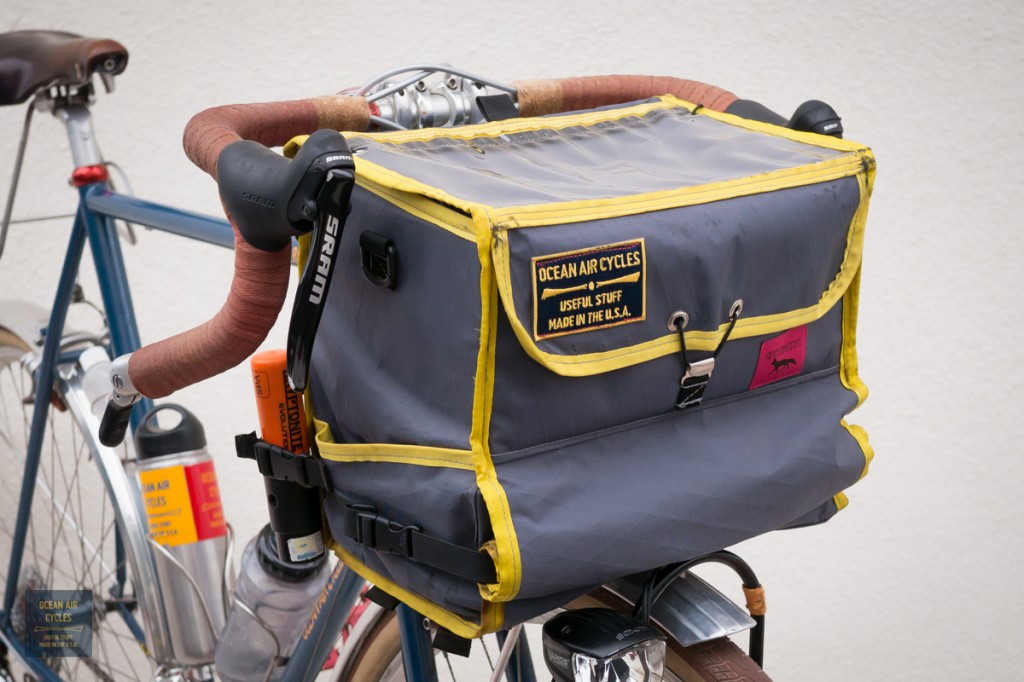

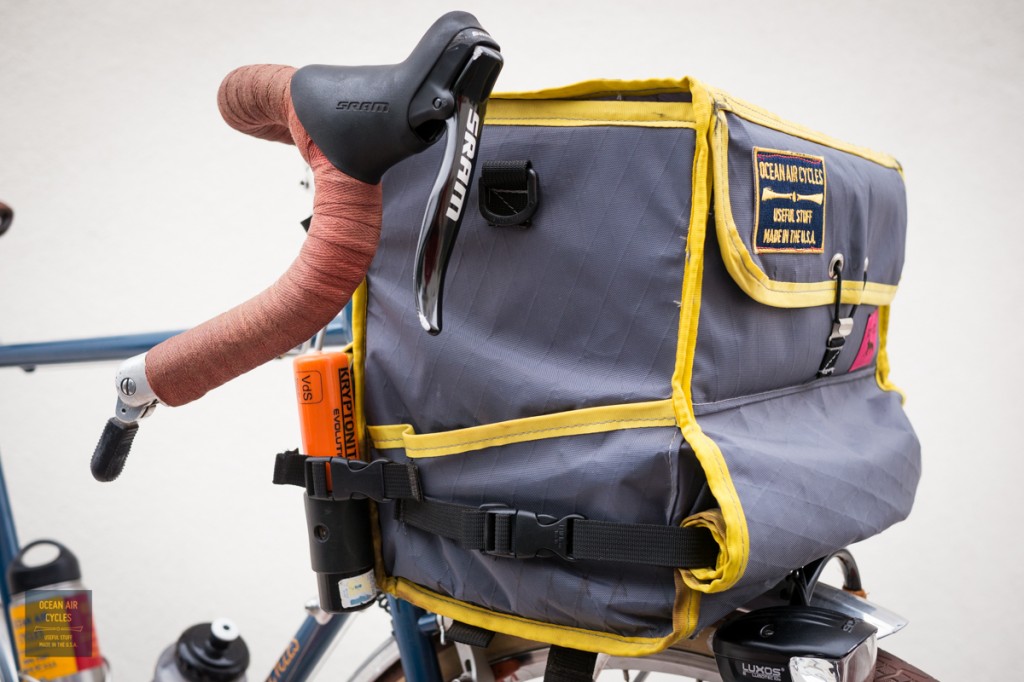
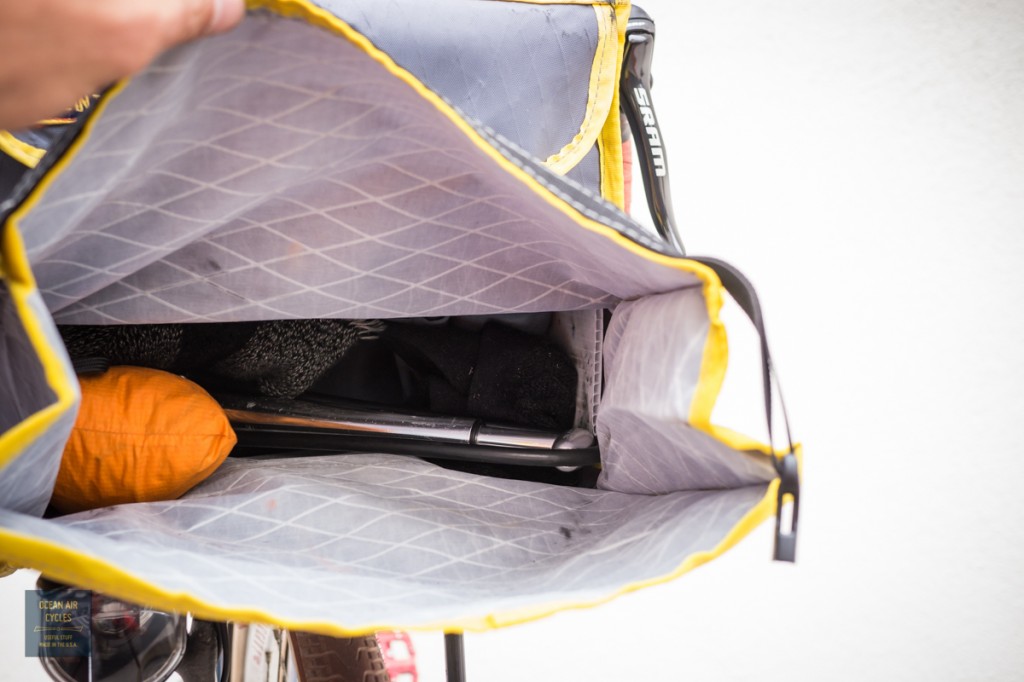
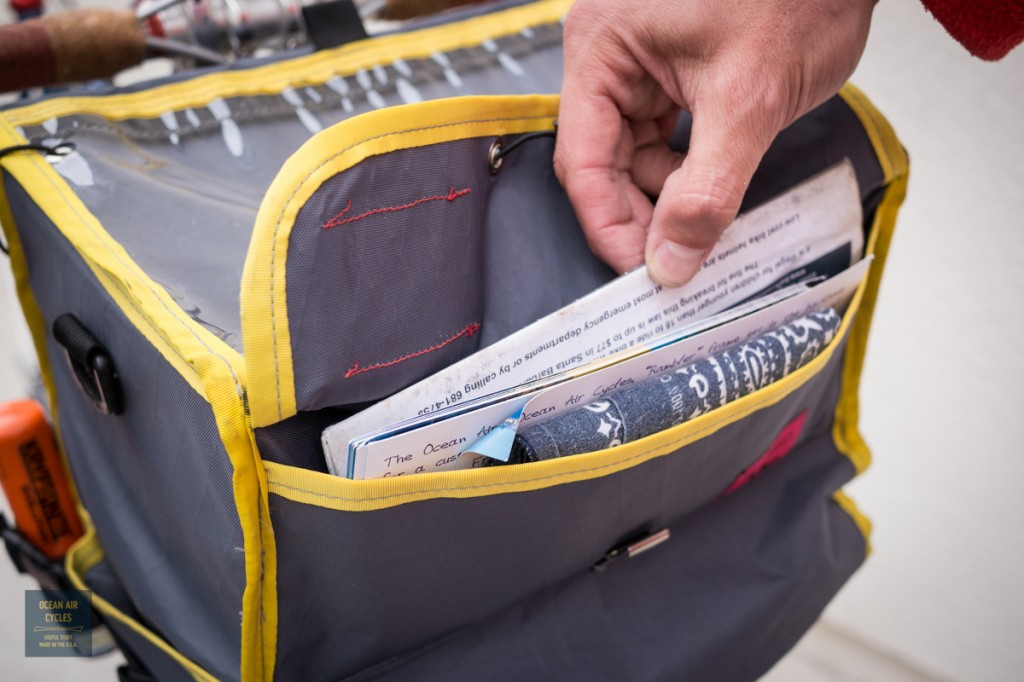
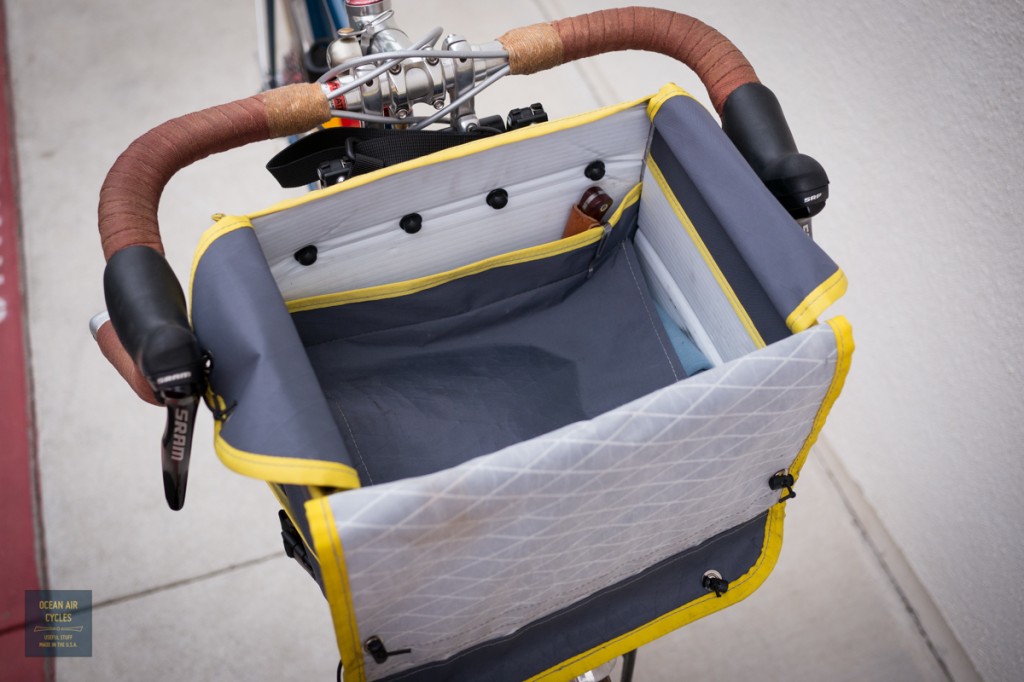
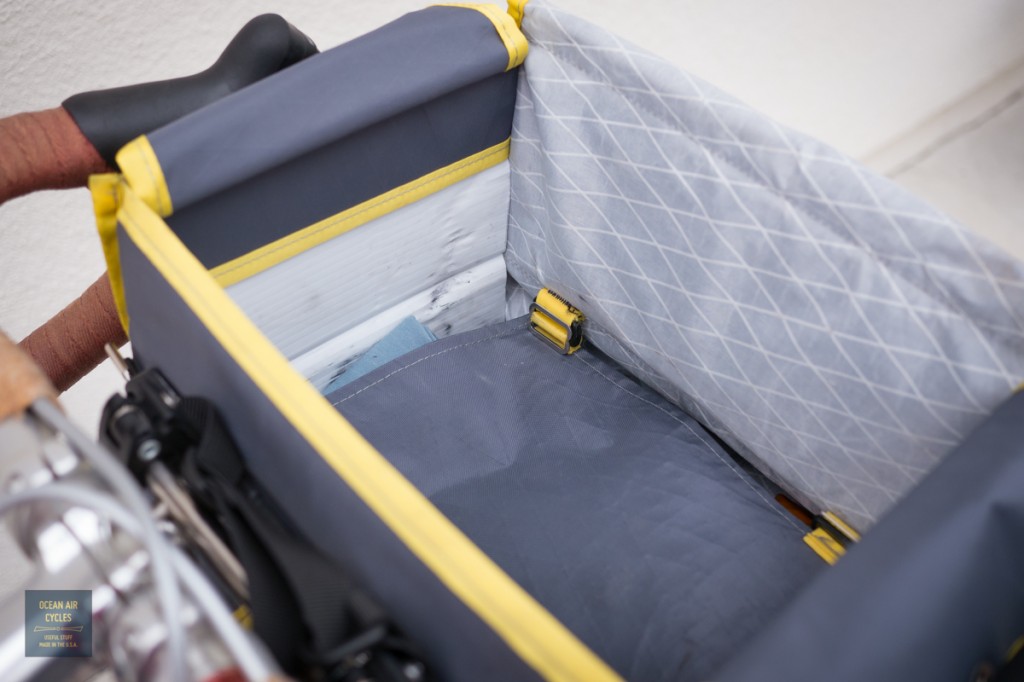
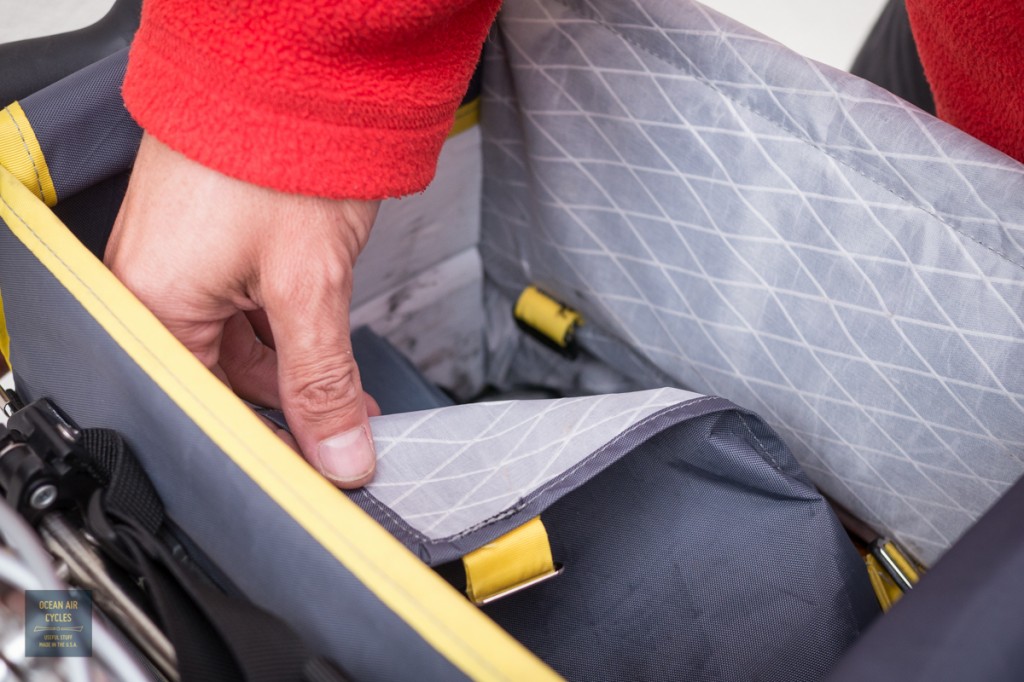
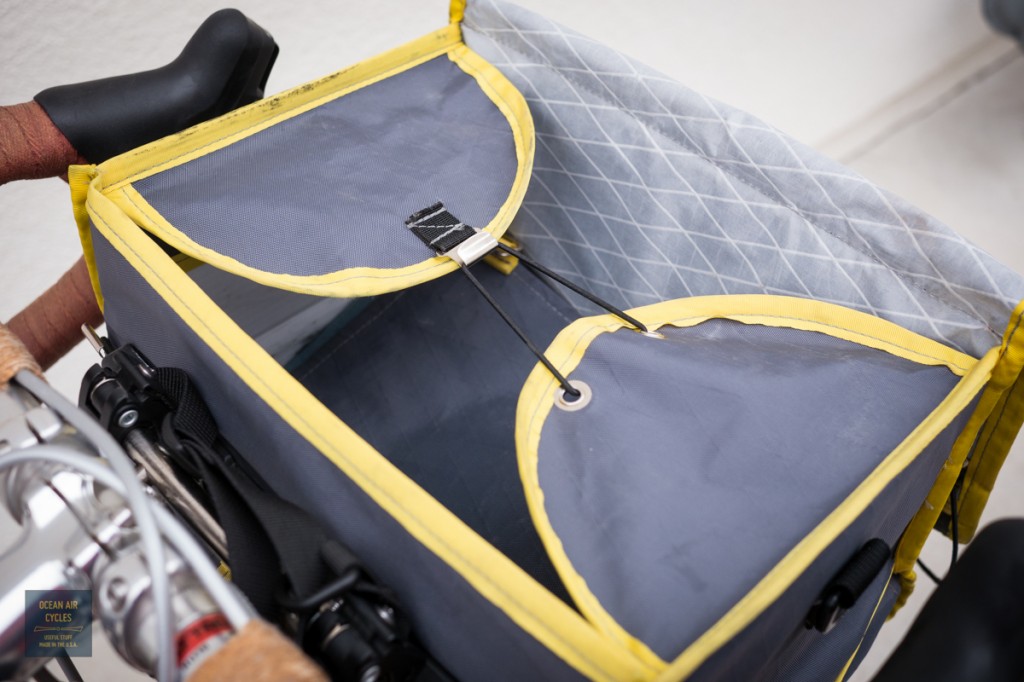
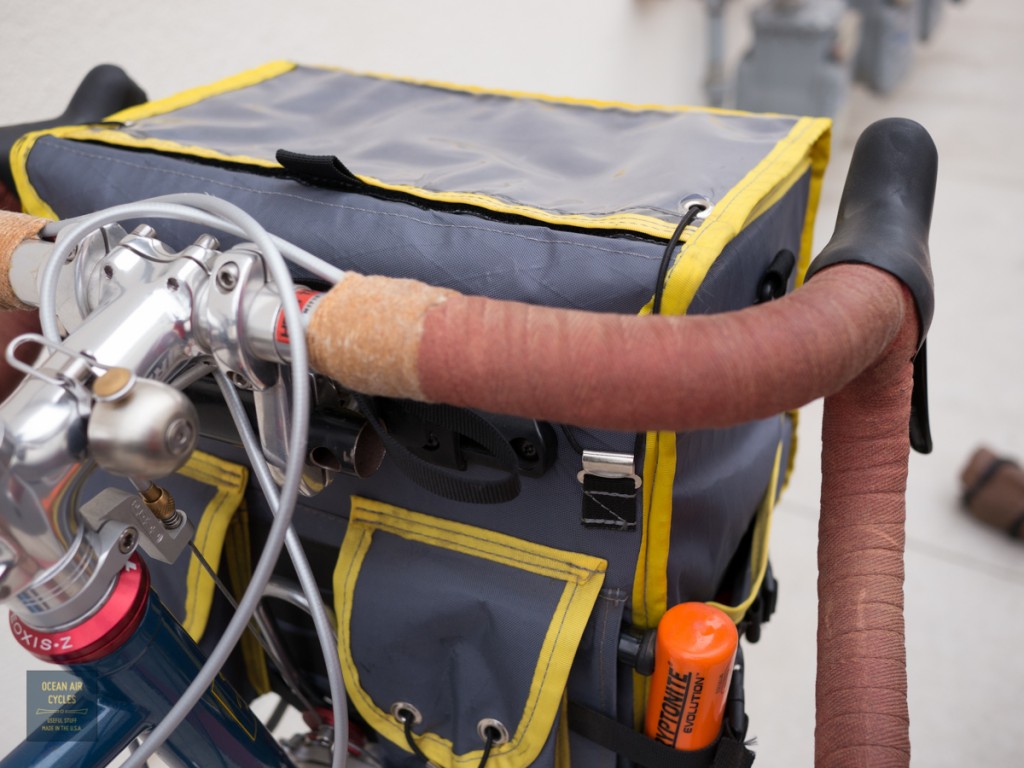
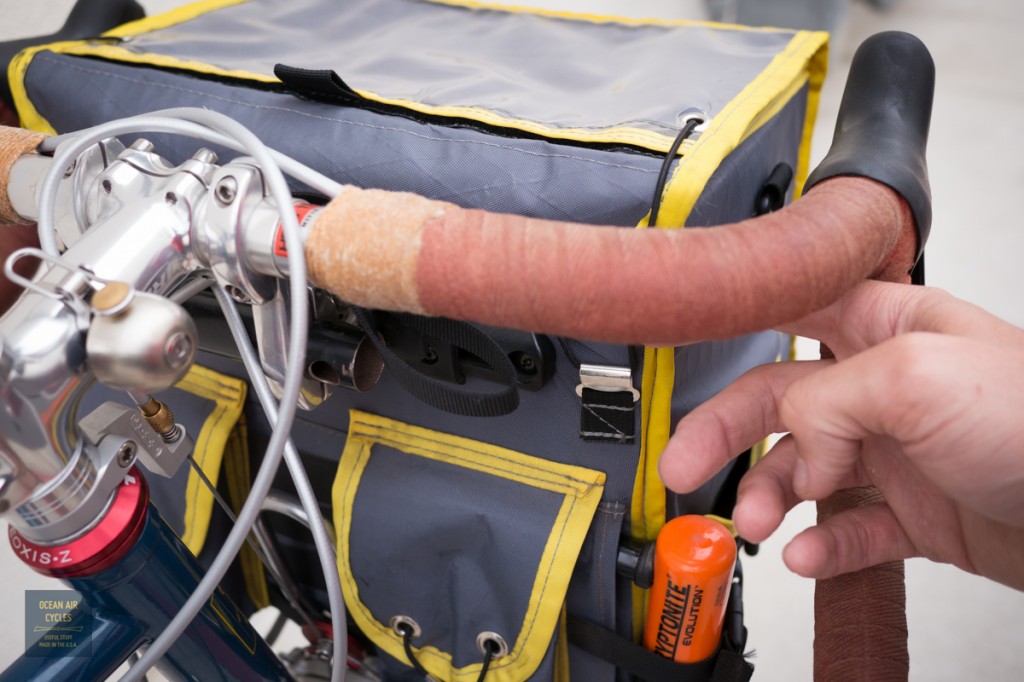
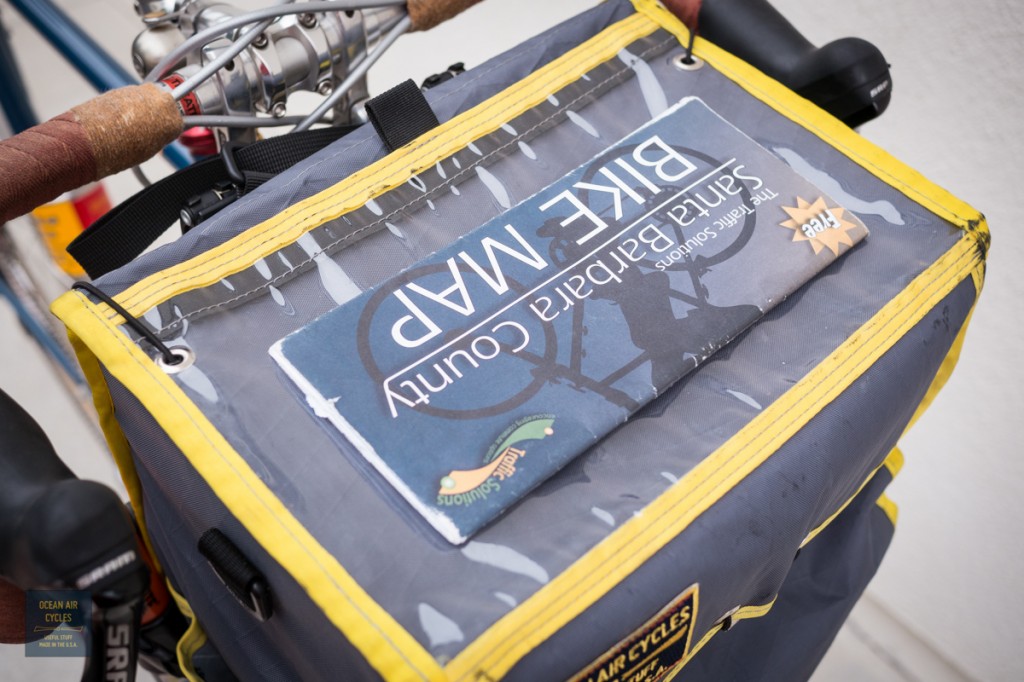
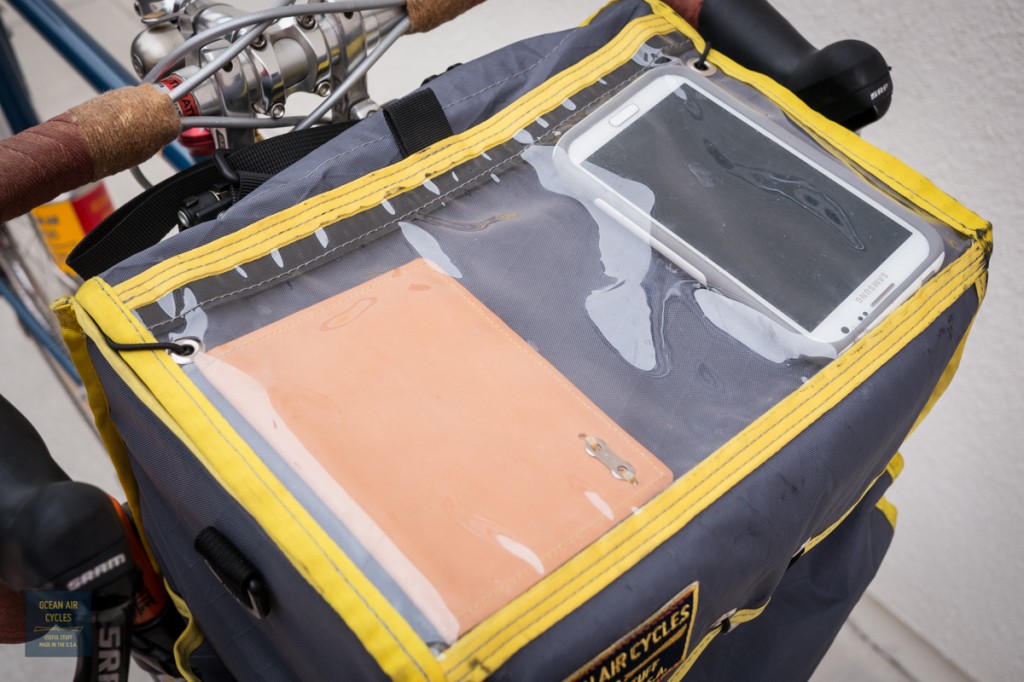
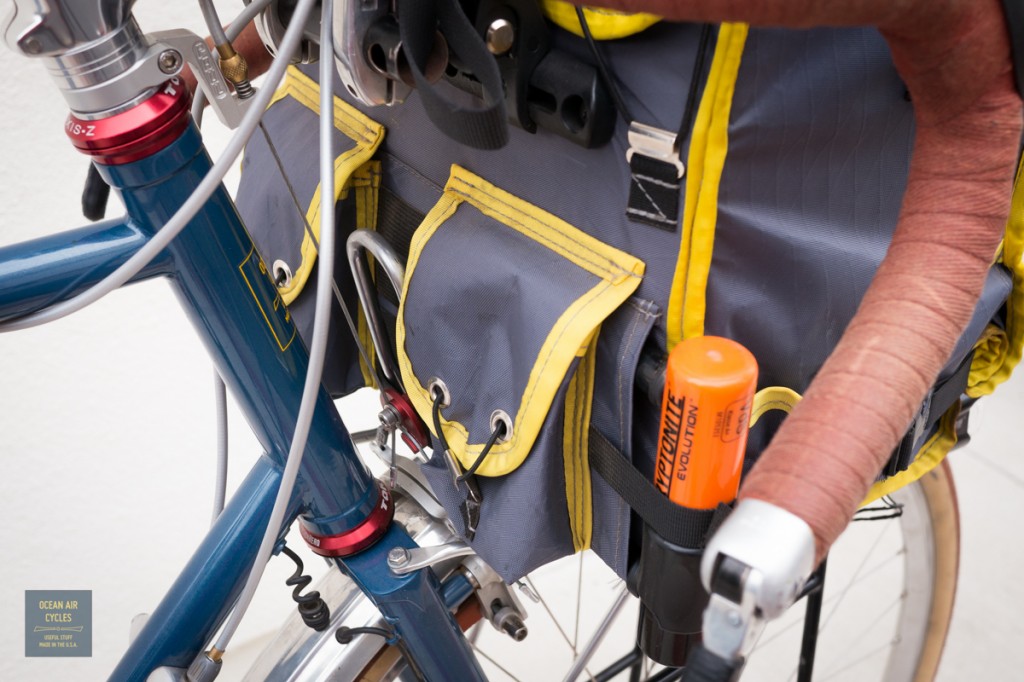

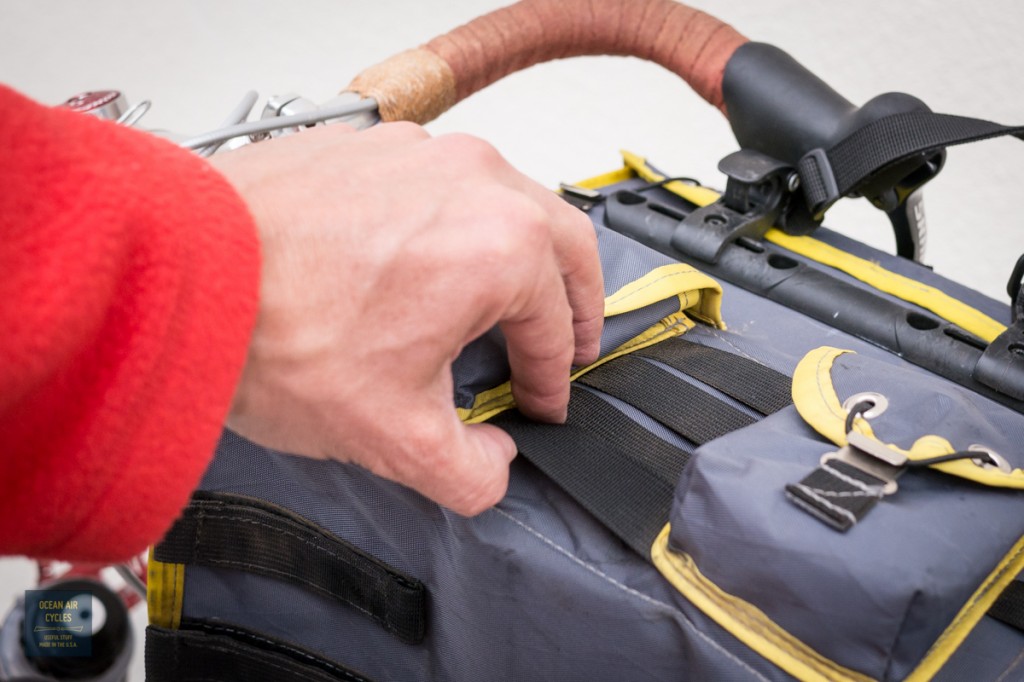 By Rando Bag standards this is a huge bag. It is both tall and wide. Wide enough to fit 1 dozen eggs, and deep enough front to back to fit a second dozen as needed. Overall dimensions of the main compartment are 28cm tall x 21cm deep x 30 cm wide. There is 37cm of space between the inside faces of my break hoods, while I do not have any problems with finger rub, I would not use the bag if yours are any narrower.
By Rando Bag standards this is a huge bag. It is both tall and wide. Wide enough to fit 1 dozen eggs, and deep enough front to back to fit a second dozen as needed. Overall dimensions of the main compartment are 28cm tall x 21cm deep x 30 cm wide. There is 37cm of space between the inside faces of my break hoods, while I do not have any problems with finger rub, I would not use the bag if yours are any narrower.
The main compartment has a removable partition to keep your loads separate. Tall bags can quickly become cluttered and challenging to get stuff off the bottom. The everyday stuff like pumps, warmers and wind breakers stays on the bottom, things I want regular access too is on the top; snacks, camera gear etc. This could easily split a change of work clothes on the bottom, lunch up top etc. The partition can be removed much like an old hiking backpack to accommodate bigger items as needed. There is also a roll closure front for getting to the bottom load without having to enter through the top. .
Side pockets are standard rando bag style.
The front pocket is full width to fit all your odds and ends including full size road maps (AAA). The width caries over into the top map pocket, again easily accommodating full size maps and or your electronic device. Samsung Note 2 and meeting wallet shown for scale. the vinyl material on the top will also allow for the use of the device touch screen. The lid has two traditional inner flaps as well as top. The elastic closures have been moved from the center to corners. This allows for easier closure while riding. I generally leave one corner open for quick camera access.
The rear facing part of the bag has two traditional small pockets. In addition there is an external lock pocket. No more opening and unloading the bag to find your lock at the bottom.
There are internal stiffeners on the three vertical sides. The bottom stiffener pocket is external. In general I have never felt the need for a stiffener there, but use it as a cutting board slot on longer trips. There are also the four traditional straps Swift uses to secure their bags to a min rack. I have only needed these for rougher roads.
The bag can be secured to most traditional rando racks with the back stop strap and a decaleur system. Some type of upper support will be needed for a bag this size. Working out all of the options in this arena will be a separate post. My current system of an Ortlieb pannier hook and hacked Nitto lamp mount has been fantastic. We are refining the design, but it is not yet ready for market.
I may have skipped a couple of details, and there will be some subtle refinements as we move into production. That said the bag has exceeded all of my expectations, and is 98% perfect. Delivery time, final cost and total number made are still being worked out over the next week or so. Much of that will depend on initial interest. Stay tuned for a presale announcement, Newsletter subscribers will get fist crack at any discounts .
Rob:
As usual, you’ve put a lot of thought into this, & it shows. I’m still trying to understand the front situation for getting to the bottom without going thru the top. Probably have to wait until I see it in person.
On my bag, I added 4 D-rings to the bottom and a couple of small hooks that fit the screws holding the mini-rack to the fork. Some shock cord & I’ve got a pretty secure hold down that’s easy to remove. The original Velcro was pooping out & it was awkward to do when mounting the bag. Have to show it to you sometime. Not as elegant as a decauler but did not add any hardware up top either.
doug
The lower section opens to the front like a dry bag, or Ortlieb roll top, turned on its side.
I think I get what you did on the bottom of yours, but am looking forward to seeing it
Nice evolution of the rando bag, Rob! I’d gotten as far as the false bottom dividing the bag, but the roll access hatch is brilliant. Is there really much weight savings in the 3-layer x-pac versus the single-layer Berthoud fabric? Do you feel like the x-pac can approach the durability and waterproofing of canvas or vinyl-lined Cordura? How’s it handle UV? Keep up the great work, and I really hope you can get these to production!
The total weight for the docena was close to that of the Berthoud 28 bag, which is significantly smaller. The fabric itself weighs about 1/3 the weight or less then the canvas used by berthoud, and 1/5 of the #8 or heavier duck used by Ruthworks, Watanabe and the like. Once you start adding in stiffiners and hardware the playing field levels a bit. THe docena also weighed in about 20% lighter than a comparable Swift bag made with Cordura and the Vinyl liner. With one bag the weight savings is not that much, but if you use the logic across a Doceana, set of panniers, frame bag and saddle bag for a full touring kit it adds up quickly to about a 5lb savings. Waxed canvas looks cool, but is crazy heavy for the purpose. In a standalone waterproofing test of the material, the XPac would crush the canvas, the mylar inner sheet is completely water tight. THe seams are the weak point in all of the bags. Experience has led me to think that standard seams are just fine for 99% of us. If complete waterproofness were a requirement, one could seal the seams on the inside, or use a secondary dry bag for specific gear. Long term durability of the material with respect to UV has been pretty good. The face material is 210 denier pack cloth and holds up as well as it would otherwise. The laminating process is based on their sail making tech and has proven robust at that application, which is much harder on the materials than a bar bag. The 210 denier cloth is not well suited to perpetual rubbing and abrasion at a hard edge, like a bottle boss on the inner frame. This is why frame bag builders will generally opt to use ballistic cloth on the contact surfaces of the bags. In general the only parts of the bar bag designs that see abrasion are the edges, and they are protected with the binding material. Standard urethane linings on Cordura break down and either peel or get gummy after 8-10 years, this makes me nuts and why I worked so hard on sourcing an alternative. The conventional bag work around for the Cordura is to use a lining, or take the usable lifespan for what it is. We may explore both in the coming years, but I would rather start with XPac as what I view as the best available option. I think the current thermal plastic coating tech for pack cloth holds the most promise, think lightweight ortlieb material, but it is still maturing a bit as a technology.
Thanks a bunch, Rob! Great info. I think Jan & BQ surprised some people (including me) when he noted how surprisingly light the Berthouds are. I made a coroplast bar box about the size of the smallest Berthoud and didn’t beat the weight by that much! It’s great to see someone like you pushing the envelope without just assuming the synthetics are going to make a lighter/cheaper/better bag.
I’m totally with you on the PU coatings. Not at all interested in something with an expiration date like that. The x-pac sounds really impressive, and the size just looks dreamy. Can’t wait to see these bags in the wild!
Nice! Congratulations to Martina for tackling this project. There are a lot of design elements in there for sure.
Hi Rod,
The bike bell is beauty. Would you mind to tell me the brand & model? Thanks!
Teh bell is from http://www.spurcycle.com/ They launched through kickstarter, and I think they may just now be getting closer to regular production
Thanks a lot!
I’ll get order in July.
makes me kinda wish I had held off on my swift ozette, but I have an ozette and I like that.
I do wish that the main access flap (top) had some overhang on the sides and back to keep rain from going into the bag. That’s the only real downside I’ve found to the swift bags. They’re pretty good in a light shower, but if you’re find yourself in real heavy rain or in the storm for the long haul, expect your stuff to get wet.
I also really like the u-lock dock.
Great bag! When can we expect pre orders?
Hey Rob, thanks for sharing all the info and photos of your new bag. As a huge fan of the traditional rando bag, I think there are some interesting design ideas there.
With respect to the elastic closures for the top lid: since the closures have been moved to the corners, does that mean that the grommets on the production bags will be placed through the map case vinyl, like on your prototype? That would seem to negate the water-resistance of the map case , but maybe I’m missing something.
Yes, the grommet currently pent rates the map case. The compression of the grommets keeps things as water resistant as the stitches at the edges and velcro closuee. If total waterproofness is required I would recommend a secondary inner bag for the map or device
Cool, thanks for the clarification.
what kind of binding material do you use on the edges, can it resist some rain?
I gather the laminate is not recyclable, or is it?
How do you feel about the service life ending centuries before the materials degrade? I suppose there may be some reclamation processes if we all make it another 50 years.
Personally, I’ll be digested, decomposed, or incinerated by then.
Love the design. That part’s brilliant.